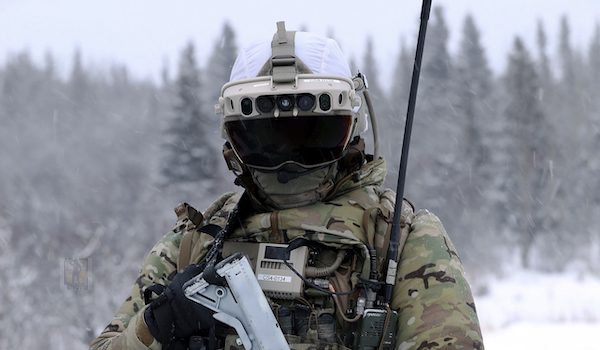It has been a long time coming for the United States Military working on a heads up display, computer aided, system for the common grunt. The program originally started back in the 1990’s with the Land Warrior program. That was scraped due to it being too heavy, among many other concerns. The program advanced over the past couple of decades and now we reside at the precipice of the latest models production release. In conjunction with Microsoft Corporation, the United States Army is planning on fielding the first Integrated Visual Augmentation System, IVAS for short, in September of this year.
What’s an IVAS?

Recently, the heavily tested and redesigned prototype has gone to production, as the hardware issues seem to be solidified. However, the military still wants to field test the production model and tweak the software as needed. So what the hell is an IVAS? It is a large Augmented Reality Visor that attaches to the front of a soldiers helmet. It is angled to come to the tip of the nose and encompasses the entire periphery of the soldiers vision. The IVAS looks like a Snow Boarders visor, with cameras and sensors above it and a cable coming out of it.
It uses holographic technology based on the Microsoft HoloLens, to display vital information in the field of view of the soldier. This system is meant to be teamed up with the Next Generation Squad Weapon, NGSW, and the NGSW Optic to maximize its potential. With these 3 systems married together, the IVAS’s true abilities can be seen. Imagine the aim-point of your weapon being displayed in your field of vision, in realtime, as your visor and weapon are married via a wireless link. Yes, it’s like a damn video game. Well at least the information provided is. Combat is never “like a video game.”
What does it Display?

The IVAS displays augmented reality video and graphics of the battlefield map, radar and sensor data, every soldier wearing the IVAS, waypoints, messages, suspected enemy locations, tracked enemy vehicles and troops, and the wirelessly linked gunsight, that we know about. And with just those capabilities there, soldiers in testing have reported “Great Success,” in the words of Borat. There is no telling what top secret capabilities this visor has. Facial recognition and next generation sensors have been reported. What does “next generation sensors” mean? You got me. Such is classified information.
Navigation Near and Far

However, a certain test soldier described how he and his element used the system in a training scenario. They had to assault a certain trench entrance under the cover of smoke. The element leader was able to mark the exact waypoint and have that waypoint displayed in real time in their fields of view. They even plotted a route to follow, so everyone stayed in their lanes and ended up at the trench entrance safely and on time. When executing the drill, the soldiers where impressed how oriented they where with the IVAS, in a highly disorientating situation.
Other soldiers in testing from the 82nd Airborne have reported that even on long 4 hour cross country treks in a heavy downpour of rain, the system functioned perfectly. In a long march across rough terrain and in crap conditions, again, all soldiers ended up exactly when and where they needed to be. But land navigation isn’t the only advantage of the IVAS. I’m most excited about the realtime gunsight display. Yet this seems to be a potential snag when firing your rifle traditionally.
Some IVAS Issues
Gen 3 models of the system where said to be too bulky on the face. Soldiers where unable to get a proper check to stock weld for marksmanship like they where taught in bootcamp. This made for awkward and untrained firing positions like putting the stock under the armpit, like Rambo. It is unclear if this issue is resolved, but according to the pictures I have found, it doesn’t seem so. Maybe this is a reason for the hold until September 2022 for deployment. Who knows, Army won’t reveal that information. It wouldn’t be difficult to fix, just reduce the amount of visor on the left and right lower sides. Giving it more of a V shape. There, done. We’ll see what Microsoft and the Army come up with later this year.

But even without that being fixed, the IVAS is still game changing. The visor displaying the NGSW’s aim-point and a camera image of the NGSW optic is formidable to say the least. Now, you can hold your weapon out from cover while you are still safely behind it. You can train your weapon on target and take protected shots from cover. This is amazing. Never before have we achieved this ability. This will save the lives of many services members in combat. Talk about over matched. The enemy will only see weapons poking out of cover, if they’re lucky.
High Tech Threats
That or an adversary realizes how to use a tactical EMP to blind all of our soldiers then cut them all down like dried saplings with a chainsaw. And then there’s the danger of being hacked. Imagine all of your soldiers being literally led off a cliff. That would be no bueno amigo. But I’m sure the egg heads over at Microsoft are on top of that.

In the end, we will see if Microsoft and the military abide by their own September 2022 deadline. There is a good chance this will be irrelevant technologically before it can be fielded. That is a looming possibility with the ever-changing and always evolving modern battlefield. As soon as more information becomes available, W&B will bring it straight to you. After all, it’s hard to think of something more awesome to a gun guy than a 21st century next generation augmented reality soldier system.







One Comment